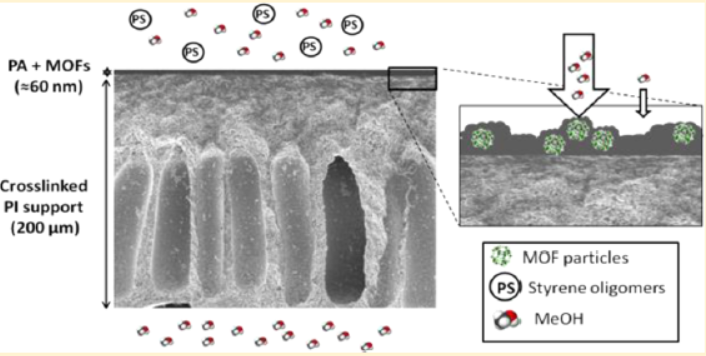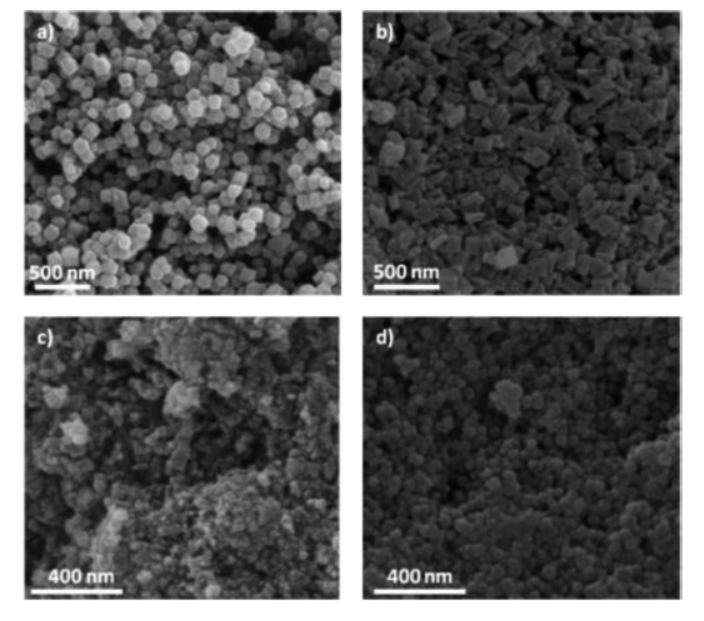Home >
News > High Flux Thin Film Nanocomposite Membranes Based on Metal−Organic Frameworks for Organic Solvent Nanofiltration
High Flux Thin Film Nanocomposite Membranes Based on Metal−Organic Frameworks for Organic Solvent Nanofiltration
Summary:
The authors from Imperial College (UK) and Universidad de Zaragoza (Spain) developedMOF-based thin film nanocomposite (TFN) membranes with high solvent permeance and stable rejection, achieving exceptional performance in the application oforganic solvent nanofiltration (OSN).

Background:
1. To address the challenges of OSN membranes—poor solvent stability, low flux, and difficulty balancing permeance and rejection—previous researchers developed integrally skinned asymmetric polyimide membranes and thin film composite (TFC) membranes. However, asymmetric polyimide membranes have limited flux for some organic solvents, and traditional TFC membranes lack significant flux enhancement.
2. The authors proposed an innovative method: embedding 50–150 nm metal–organic framework (MOF) nanoparticles (ZIF-8, MIL-53(Al), NH₂-MIL-53(Al), MIL-101(Cr)) into the polyamide (PA) thin layer via in situ interfacial polymerization. This method improved solvent permeance by 160–488% while maintaining >90% rejection.
Research Content:
1. Synthesis
-MOF synthesis: ZIF-8 was prepared via solvothermal reaction of zinc nitrate hexahydrate and 2-methylimidazole in methanol at 150 °C for 5 h; NH₂-MIL-53(Al) and MIL-53(Al) were synthesized by solvothermal treatment of aluminum nitrate nonahydrate with 2-aminoterephthalic acid/terephthalic acid in DMF (130 °C for 3 days, 120 °C for 1 day, respectively); MIL-101(Cr) was synthesized via microwave reaction of chromium chloride hexahydrate and terephthalic acid in water at 180 °C for 30 min.
-TFN membrane synthesis: MOFs were dispersed in the trimesoyl chloride (TMC)/hexane organic phase, then interfacially polymerized with m-phenylenediamine (MPD)/water on cross-linked polyimide (PI P84) supports; post-treatment (DMF filtration for 20 min) was used to optimize performance.
2. Characterizations
1.BET and pore size distribution: MIL-101(Cr) had the highest BET surface area (2306 m²·g⁻¹) and pore volume (1.52 cm³·g⁻¹), with pore diameters of 1.6/3.4 nm; ZIF-8 had a BET surface area of 1410 m²·g⁻¹ and pore diameters of 0.34/1.29 nm.
2.SEM/TEM tests: All MOFs had nanometric particle sizes (ZIF-8: 100±10 nm; MIL-101(Cr): 47±6 nm); TEM showed the PA-MOF layer thickness was 54±10 nm, with no nonselective voids between MOFs and PA.
3.Other tests: XRD confirmed MOF crystallinity; TGA showed MIL-101(Cr) had the highest water adsorption (1.7 g/g MOF); contact angle tests showed hydrophilic MOFs (MIL-101(Cr)) reduced membrane contact angle (to ~43°); EDX detected 7.3 wt% Cr in TFN-MIL-101(Cr) membranes, confirming MOF incorporation.
3. Application
-OSN performance: For MeOH/PS systems, TFN-MIL-101(Cr) membranes had a permeance of 3.9 L·m⁻²·h⁻¹·bar⁻¹ (160% higher than TFC); for THF/PS systems, permeance reached 11.1 L·m⁻²·h⁻¹·bar⁻¹ (488% higher than TFC). All membranes maintained >90% rejection, with MWCO <232 g·mol⁻¹ (MeOH) and ~295 g·mol⁻¹ (THF).
4. Mechanism
-Flux enhancement: MOF pores provide preferential solvent flow paths; MIL-101(Cr)’s large mesopores and high porosity maximize this effect.
-High rejection: The PA layer surrounds MOFs tightly (due to MOF-organic ligand-PA interactions), avoiding nonselective voids; size exclusion of PA and MOFs ensures >90% PS rejection.
-Solvent effect: THF (lower viscosity, weaker interaction with hydrophilic MIL-101(Cr)) had higher flux than MeOH.

Outlook:
This research first applied MOFs to TFN membranes for OSN, realizing a balance between high flux and stable rejection. It proves that mesoporous MOFs (e.g., MIL-101(Cr)) can significantly improve membrane transport properties, providing a new direction for high-performance OSN membrane development (e.g., combining micro/mesoporous MOFs for tunable performance).
High Flux Thin Film Nanocomposite Membranes Based on Metal−Organic Frameworks for Organic Solvent Nanofiltration
Authors: Sara Sorribas, Patricia Gorgojo, Carlos Tellez, Joaquín Coronas, Andrew G. Livingston
DOI: 10.1021/ja407665w
Link: https://pubs.acs.org/doi/10.1021/ja407665w
The above review is for academic progress sharing. For any errors or copyright issues, please contact us for correction or removal.

